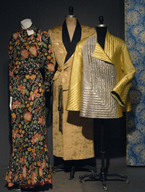|
In the 20th century,
fashion designers increasingly appropriated features of
non-Western dress construction, such as asymmetry and wrapped
fabric. Unlike simple decorative applications of exotic motifs,
these designs broke with Western traditions, emphasizing
otherness in form and style. Fashion, colonialism, and modernism
coalesced into a coloniale moderne style promoted at the Paris
Exhibitions of 1925 and 1931. Exoticism “communicate[s]…the
establishment of a modern style,” declared exhibition
organizers, because “certain indigenous styles have an
impressive originality in form, color, [and] materials.” (The
rise of modernism to some extent repudiated the prewar period’s
lush Orientalism, embracing instead industrial and “primitive”
forms, and a simpler, streamlined aesthetic.)
 November 27, 2007 -
May 7, 2008
November 27, 2007 -
May 7, 2008
|



